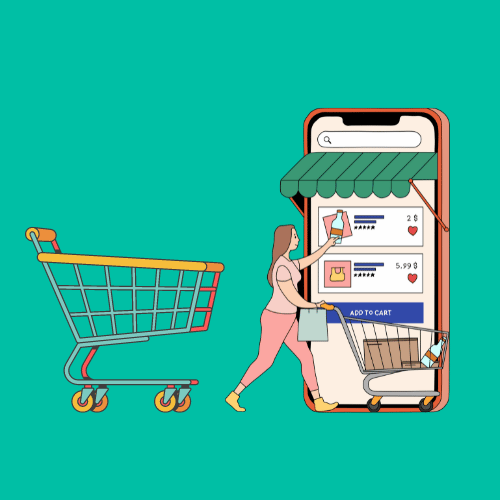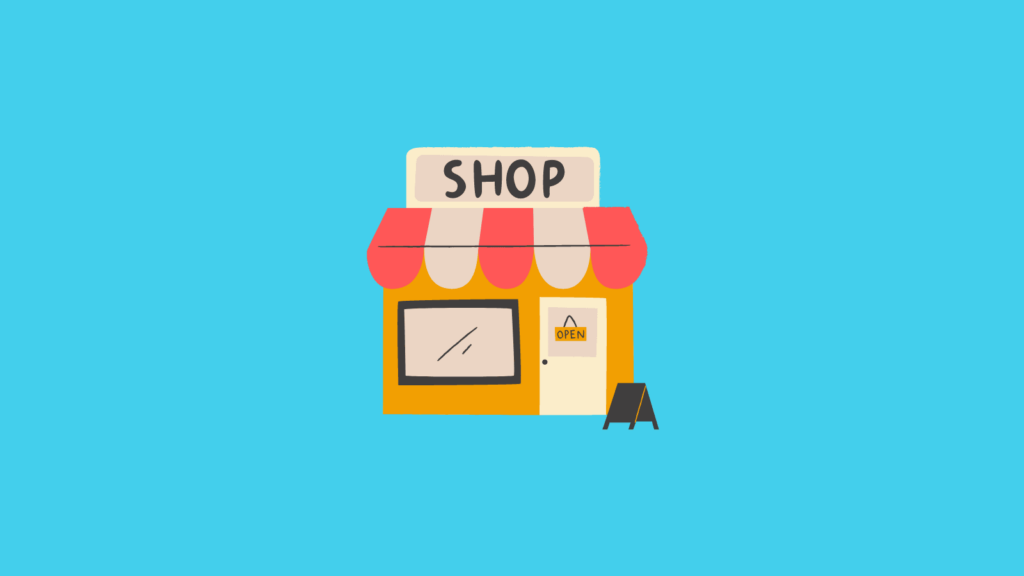Online Shopping vs. Traditional Shopping: Pros and Cons
Find out the pros and cons of online and traditional shopping and decide which one is right for you.

Shopping has come a long way from the days of wandering through brick-and-mortar stores. The rise of the internet has led to a massive shift in how people buy goods and services. Today, consumers can choose to shop online or visit a physical store. While both methods have their advantages, each also comes with its own set of disadvantages.
In this article, we will explore the pros and cons of online shopping and traditional shopping to help you make an informed decision.
In this article
Online Shopping Statistics
In 2022, there were 268 million online shoppers in the United States. This number is projected to increase to almost 285 million online shoppers in 2025.
According to recent estimates, global e-commerce sales will reach $58.74 Trillion by 2028. This represents a significant increase from previous years and indicates the growing popularity of online shopping.
Additionally, online retail sales are projected to grow at a compound annual growth rate (CAGR) of 14.6% from 2021 to 2028. This means that the online shopping industry is expected to continue growing at a rapid pace for the foreseeable future.
If we’re looking at statistics by gender, the difference between the percentage of male and female shoppers isn’t a breath stopper. 72% are women, while 68% are men.
What is Online Shopping?

Online shopping is a type of electronic commerce that allows consumers to buy products and services through the Internet. Just like in Temu, with just a few clicks, consumers can browse through thousands of products from various vendors and make a purchase without leaving their homes. Online shopping has become increasingly popular in recent years, thanks to its convenience and cost-effectiveness.
Advantages of Online Shopping
Convenience and Flexibility
The convenience and adaptability offered by buying online cannot be equaled. Customers are able to purchase from the convenience of their own homes, workplaces, or even while they are traveling. This flexibility is especially helpful for people who have a lot of things going on in their lives, have trouble moving about, or live in more isolated regions.
Wider Range of Products
Online shopping provides access to a vast range of products from around the world. Consumers can easily compare prices and features of different products from different vendors without the need to physically visit multiple stores.
Cost-Effective
Online shopping can save consumers a significant amount of money. Online stores typically have lower overhead costs than physical stores, which allows them to offer lower prices on products. Additionally, online shopping offers the ability to easily compare prices between vendors to get the best deals.
Time-Saving
Online shopping is a time-saving method of shopping. Consumers can easily find what they are looking for by searching for specific products, and checkout takes only a few minutes. This is in contrast to traditional shopping, which can involve spending hours traveling to different stores and searching for products.
No Crowds and Queues
With online shopping, there is no need to contend with crowded stores or stand in line for a very long time. Customers don’t have to go through the anguish and inconvenience of standing in line to pay for their items, which saves them time and stress.
Disadvantages of Online Shopping
Lack of Physical Inspection
One of the biggest drawbacks of online shopping is the inability to physically inspect products before making a purchase. This can result in purchasing products that do not meet expectations or do not fit as desired.
Delayed Delivery
Online shopping involves waiting for the products to be delivered, which can take several days or even weeks depending on the vendor and location. This can be inconvenient for those who need the product immediately.
Risk of Fraud and Scams
When customers make purchases online and provide sensitive information such as their name, address, and credit card numbers, they put themselves in danger of falling victim to con artists who are looking to take advantage of them. This could result in the loss of money or the theft of your identity by another person.
No Personal Interaction
Traditional purchasing gives more opportunities for personal engagement than shopping online. The fact that customers cannot ask questions or receive fast assistance from sales personnel can make shopping a less enjoyable experience for many customers.
Returns and Exchanges
When you shop online, the process of making returns and exchanges can be more difficult. The procedure may require sending the product back to the seller, after which the customer must wait for a replacement or refund, both of which can be time-consuming and expensive processes.
What is Traditional Shopping?

Traditional shopping, also known as brick-and-mortar shopping, involves physically visiting a store to buy products or services. This method has been around for centuries and is still a popular way to shop, especially for those who prefer to inspect products before purchasing.
Advantages of Traditional Shopping
Immediate Gratification
Traditional shopping offers immediate gratification. Consumers can purchase products and take them home immediately, without waiting for delivery.
Tangible Shopping Experience
Traditional shopping offers a tangible shopping experience. Consumers can physically inspect products before making a purchase, which can be beneficial when purchasing items such as clothing or furniture.
Personalized Service
Traditional shopping provides personalized service from sales associates who can answer questions and provide assistance. This can result in a more satisfying shopping experience.
Social Interaction
Traditional shopping offers social interaction, which can be enjoyable for some consumers. Shopping can be a social activity, and some people enjoy the experience of shopping with friends or family.
No Shipping Fees
Traditional shopping eliminates the need to pay shipping fees, which can be costly with online shopping.
Disadvantages of Traditional Shopping
Time-Consuming
Traditional shopping can be time-consuming, especially if consumers need to travel to multiple stores to find what they are looking for.
Limited Range of Products
Traditional shopping provides access to a limited range of products compared to online shopping. Consumers may need to visit multiple stores to find the product they want.
Higher Prices
Traditional shopping can be more expensive than online shopping, as physical stores have higher overhead costs.
Crowded Stores and Queues
Traditional shopping can involve dealing with crowded stores and long queues, which can be stressful and inconvenient.
Limited Availability
Traditional shopping can be limited by store hours and availability. Consumers may not be able to purchase products outside of store hours or during holidays.
Conclusion
Online shopping and traditional shopping both have their advantages and disadvantages. The decision of which method to choose depends on individual preferences and circumstances. Online shopping offers convenience, cost-effectiveness, and a wider range of products, but lacks the personal interaction and physical inspection of products that traditional shopping provides. Traditional shopping offers immediate gratification, personalized service, and social interaction, but can be time-consuming and more expensive. Ultimately, the choice between online and traditional shopping depends on what is most important to the consumer.
FAQ
Q: What is traditional shopping?
- Traditional shopping refers to the conventional method of purchasing goods or services in physical stores. Customers visit brick-and-mortar locations to browse, select, and purchase items.
Q: How does traditional shopping differ from online shopping?
- Traditional shopping involves physically visiting stores, providing tangible product experiences, and immediate purchases. In contrast, online shopping offers convenience, a wider selection, and often better pricing, but lacks the physical interaction with products.
Q: What are the benefits of traditional shopping?
- Benefits include the ability to see, touch, and try products before purchase, instant gratification, no shipping costs, and personal interaction with sales staff.
Q: Are there any disadvantages to traditional shopping?
- Disadvantages include limited store hours, necessity to travel to the store, potentially higher prices, and a more limited product selection compared to online stores.
Q: What types of products are best suited for traditional shopping?
- Products like clothing, footwear, and perishable goods are often better suited for traditional shopping due to the need for physical examination or fitting.
Q: How has traditional shopping changed in recent years?
- Traditional shopping has evolved with technology integration like digital payments, augmented reality in fitting rooms, and enhanced customer service experiences.
Q: Can traditional shopping be environmentally friendly?
- Yes, traditional shopping can be environmentally friendly, especially when local businesses are supported, reducing transportation emissions and packaging waste.
Q: What is the impact of traditional shopping on local economies?
- Traditional shopping supports local economies by sustaining local businesses, creating jobs, and contributing to local taxes, which in turn fund community services and infrastructure.
Q: How do seasonal sales impact traditional shopping?
- Seasonal sales, such as Black Friday or holiday discounts, significantly boost traditional shopping, attracting more customers through special deals and promotions.
Q: What is the role of customer service in traditional shopping?
- Customer service is crucial in traditional shopping, providing personalized assistance, answering questions, helping with selections, and improving the overall shopping experience.
Q: How can traditional shopping experiences be enhanced?
- Shopping experiences can be enhanced through store ambiance, knowledgeable staff, loyalty programs, and integrating technology like virtual try-ons or digital catalogs.
Q: What are some challenges faced by traditional shopping outlets?
- Challenges include competition with online retailers, maintaining foot traffic, adapting to changing consumer preferences, and managing overhead costs like rent and utilities.
Q: How does traditional shopping cater to different age groups?
- Traditional shopping caters to various age groups by offering diverse product ranges, store layouts, and marketing strategies that appeal to different demographics.
Q: Can traditional shopping be a sustainable option?
- Yes, it can be sustainable, especially when stores implement eco-friendly practices like reducing packaging, using renewable energy, and offering locally sourced products.
Q: How do return and exchange policies work in traditional shopping?
- Return and exchange policies vary by store, but generally, customers can return or exchange products within a specified period, often requiring a receipt and the item in its original condition.
Q: What is the future outlook for traditional shopping?
- The future of traditional shopping likely involves a blend of physical and digital experiences, focusing on unique in-store experiences, customer service, and community engagement.
Q: How do cultural factors influence traditional shopping?
- Cultural factors greatly influence traditional shopping, including local traditions, holidays, and consumer behavior, shaping the types of products offered and the shopping experience itself.
Q: What is the role of window displays and store design in traditional shopping?
- Window displays and store design play a crucial role in attracting customers, enhancing the shopping experience, and reflecting the brand’s identity and values.
Q: How do social interactions influence traditional shopping experiences?
- Social interactions, such as shopping with friends or family and interacting with store staff, add a personal touch to traditional shopping, often making it more enjoyable and informative.
Q: How do traditional shopping districts contribute to urban life?
- Traditional shopping districts contribute to urban life by creating lively, walkable areas that foster social interaction, cultural expression, and economic activity.
Q: What is the importance of location in traditional shopping?
- Location is key in traditional shopping, as accessibility, visibility, and proximity to targeted customers significantly impact foot traffic and sales.
Q: How do traditional retailers adapt to changing consumer trends?
- Traditional retailers adapt to changing consumer trends by updating their product offerings, embracing new technologies, and enhancing customer service to meet evolving preferences and expectations.
Q: What is the significance of traditional markets or bazaars?
- Traditional markets or bazaars hold cultural significance, offering unique, often handmade goods, fostering community ties, and providing a sense of local tradition and authenticity.
Q: How does traditional shopping benefit artisans and small producers?
- It benefits artisans and small producers by providing a platform to showcase and sell their products directly to consumers, often allowing them to retain a greater share of the profits.
Q: Can traditional shopping be combined with online elements?
- Yes, many traditional retailers combine in-store shopping with online elements, like click-and-collect services, online inventory checks, or digital loyalty programs, to enhance convenience and customer experience.
Q: How does traditional shopping influence fashion and trends?
- Traditional shopping plays a significant role in fashion and trends, as in-store displays, seasonal collections, and local shopping trends often influence consumer choices and broader fashion trends.
Sources:
- https://www.statista.com/statistics/273957/number-of-digital-buyers-in-the-united-states/
- https://www.globenewswire.com/news-release/2022/10/31/2544834/0/en/
Global-e-Commerce-Market-to-Hit-Sales-of-58-74-Trillion-By-2028-
E-commerce-Market-Has-Come-a-Long-Way-Still-Need-to-Overcome-Some-Challenges.html#:~:text=filingsmedia%20partners-,Global%20e%2DCommerce%20Market
%20to%20Hit%20Sales%20of%20%2458.74%20Trillion,Need%20to%20Overcome%20Some%20Challenges - https://www.globenewswire.com/news-release/2021/04/06/2205170/0/en/
Growing-at-14-6-CAGR-The-Global-E-learning-Market-Size-Will-Exceed-a-Value-of-374-3-Billion-by-2026.html - https://belvg.com/blog/men-vs-women-who-runs-the-online-shopping-world.html
Create more and better content
Check out the following resources and Grow!